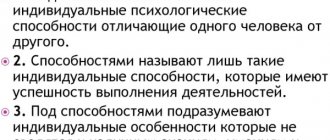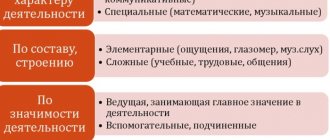Verbal-logical thinking has its own characteristics and is more characteristic of people with a mathematical mindset. This type of thinking can be developed independently with the help of special training. Verbal thinking is the competent use of words to express one’s own feelings and emotions . Unfortunately, little attention is paid to the laws of formal logic in this case. Formal transactions begin to be performed by a person at the age of eleven. At this age, the child is already able to systematize the acquired knowledge and determine the consequences, knowing the causes of a certain phenomenon.
Some researchers of this phenomenon have come to the conclusion that there is a certain connection between the level of intellectual development and school performance. American psychologist David Wexler in his report says that the strength of the relationship between academic performance and verbal intelligence is much stronger than with non-verbal intelligence.
The verbal type of intelligence is based on the simplest concepts for everyone, speech, writing, reading
Introduction
One of the compilers of the standard psychological test for assessing intelligence (IQ), R. Amthauer, identified 4 leading factors of intelligence: verbal, arithmetic, spatial and mnemonic. The Amthauer Intelligence Structure Test best meets the objectives of career guidance, because it allows you to diagnose not only the level of intelligence, but also its orientation: mathematical, humanitarian, technical.
The Amthauer intelligence structure test is attractive, firstly, because it is well automated and can be presented in a computer version, which provides many advantages for research, and secondly, it allows you to express the level of intellectual development quantitatively, in numbers.
Individual (tests) subtests are combined into a battery of tests, which allows you to immediately assess the level of development of various aspects of intelligence:
- verbal abilities
(awareness, elimination of unnecessary things, search for analogies, determination of the general); - mathematical
(arithmetic problems, determining patterns); - spatial concepts
(geometric addition, spatial imagination); - mnemonic
(memorization)
Verbal thinking is thinking that operates with abstract sign structures. For normal mental work, some people need to see or imagine objects, while others find it easier to operate with abstract sign structures.
What do IQ test results say?
Initially, IQ tests served to assess the potential of children and identify the strengths and weaknesses of their development. Some schools now use similar techniques to determine whether a child can cope with a more complex curriculum.
It is also possible to test children for the purposes of parental interest, but it will be quite difficult to objectively evaluate the results in this case. And you certainly shouldn’t criticize a child, ridicule his abilities, or use a test as proof that he’s not very smart.
If you take the test yourself and have self-analysis skills, you will understand which tasks you stumble on. Analyzing errors will help you find weak points that are worth working on.
If you are unhappy with the results and are ready to improve, I recommend reading the article on our blog about how to develop your thinking. In it you will find useful recommendations, effective exercises and tools for training your thinking.
And whatever the result, you can always take courses in the development of creative, logical and other types of thinking. After all, there is no limit to perfection!
Theory of intellectual development
The Swiss scientist Jean Piaget proposed the most developed theory of intellectual development. He identified four stages in intellectual development:
- Sensorimotor stage
- infancy. When a child searches for objects that have disappeared from his field of vision, guessing where they may be. He knows how to coordinate information coming from the senses, and the ability to take purposeful actions develops.
- Pre-operational thinking stage
. The child begins to develop verbal and conceptual thinking.
- Specific Operations Stage
Begins at about seven years of age, the child can already consider problems at a conceptual level and acquires the simplest concepts of categories such as space, time and quantity.
- Formal Operations Stage
begins at approximately 11 years of age. The child’s thinking is systematized, he is able to determine consequences based on the causes of any phenomenon.
In humans, verbal ability develops from the age of 3 from the level of simple judgments to logical conclusions based on formal and substantive rules, passing through six stages until the age of 18. Then verbal intelligence improves until the age of 55-60, and a decline occurs at the age of 65-70.
But still, with age, there is a decrease in the productivity of the main indicator of intelligence, namely “general intelligence,” due to a slowdown in the thinking process, i.e. reducing the speed of information processing. Moreover, speed indicators of intelligence can decline as early as 30 years of age.
However, there is a direct connection between the intellectual productivity of people aged 60-80 years and their profession; some intellectual functions develop over the years and into old age. Of the partial abilities, mnemonic processes (active perception and long-term storage of information) deteriorate, while the ability to retain short-term information decreases very slightly with age.
Scythe Cubes
The original test was developed by Oregon State psychology professor S. C. Kos in 1927 under the name "The Block Design Tests." The Kos Cubes test became most widely known after it was included in 1939 by American psychologist David Wexler in a battery of subtests to measure intelligence. Wexler simplified the original version of the test, reducing the number of cubes to nine, colors to two, and pattern cards to ten. To date, this modification of the test has been successfully used in D. Wechsler’s methodology for measuring intelligence. The “Kosa Cubes” test, due to the complex nature of the tasks, turned out to be the most informative in the study of non-verbal intelligence in general and began to be considered as an independent means for measuring it. The functioning of nonverbal intelligence is associated with the characteristics of perception, motor skills, visual-motor coordination, the specifics of spatial representations, constructive and heuristic abilities. “Kos Cubes,” which require the manifestation of a complex of the listed qualities, turned out to be highly sensitive to identifying non-verbal talent. The test is widely used in career guidance and selection to assess abilities for manual practical activities and intellectual prerequisites for technical abilities, in education to identify intellectual learning capabilities, in medicine to diagnose a number of neuropsychological and psychopathological symptoms.
During the testing process, the subject is asked to assemble the figure shown on the card from the available cubes. The time to work on each figure is limited. Observing the behavior of the subject during testing also allows us to obtain additional information about the qualitative uniqueness of his thought processes, the characteristics of his emotional response and character traits, and some psychopathological symptoms. The test has child and adult forms and allows you to work with people aged 5 to 75 years, adapted on a domestic sample.
The relationship between verbal abilities and academic performance
In educational psychology, the connection between the level of intelligence development and academic performance has long been noticed. According to Wechsler, verbal intelligence is more strongly related to the level of academic performance than nonverbal intelligence.
The development of individual components of the structure of intelligence determines the success of students in studying certain academic subjects.
Verbal intelligence determines the success of learning in all subjects and, first of all, in the humanities (language, literature, history, etc.).
To successfully study natural sciences, you need a high level of development of spatial and verbal intelligence; for good performance in the humanities, you need a high degree of development of verbal intelligence (sense of language, speech).
In psychology, speech is a system of sound signals, written signs and symbols used by a person to convey information, the materialization of thoughts.
How can you develop the nonverbal component of intelligence?
Nonverbal intelligence can be developed. Today, there are special techniques and exercises for this, the systematic implementation of which will help develop this substructure of intelligence.
First of all, a person seeking to develop the non-verbal structure of intelligence must learn not just to look, but to see. For example, when you see cars colliding on the road, you should not limit yourself to a superficial inspection of the situation. Attempts to see the full picture and understand the causes of the incident contribute to the development of the nonverbal component. By restoring all the factors that have fallen out of sight and the holistic picture of the situation, a person trains his intellect and develops the level of observation.
Breaking thought patterns is an equally progressive technique. At the initial stage, you can change such simple things as the route from home to work or the path taken around the store while shopping. Any change in habitual actions and pictures prompts the brain to change the picture of the environment, which becomes familiar and pulls the person into the comfort zone.
The development of the nonverbal substructure of intelligence is facilitated by reading difficult-to-perceive literature and understanding each step described in this literature. No less useful is thoughtful reading of literature concerning activities unusual for humans.
Speech and language
The main difference between speech and language is the following:
- Language
is a system of conventional symbols with the help of which combinations of sounds are transmitted that have very specific meanings and meanings for people, an objective, historically established system of codes, the subject of a special science - linguistics (linguistics). - Speech
(the subject of “psycholinguistics”) is the psychological process of formation and transmission of thought through language. Speech without knowledge of language is impossible, while language can exist and develop according to its own laws.
The determinant processes of speech and their perception (perception) by the structures (models) of the corresponding (congruent) languages and linguistic models are studied by psycholinguistics.
J. Raven's Progressive Matrices Test
This test determines the level of logical thinking using abstract material. The test can be used both individually and in group form. There is a children's (8-14 years old) and adult (14-65 years old) version of the test.
The test includes 60 tables, which are divided into 5 series and each with 12 tasks. The complexity of the tasks gradually increases, and each one is given only 20 minutes to complete. At the end of the test you will know your intelligence level. The technique is used for research purposes, in educational institutions, at work and in clinical settings.
Development of the verbal factor of intelligence depending on professional activity
If in his professional activity a person mainly needs to operate with words as symbols, then he will need a higher level of verbal intelligence.
The level of development and efficiency of functioning of this particular structure, and, consequently, the system of operating mechanisms associated with it, have a more significant impact on the productivity of intellectual activity, for example, language teachers, than the levels of development of “mathematical” and visual-figurative thinking.
The productivity of a person’s cognitive abilities decreases due to the deformation or destruction of the system of operational mechanisms of the verbal type: abstract comparison, generalization, abstraction, analysis and synthesis.
The system of functional mechanisms of cognitive abilities (the first level of intelligence) does not undergo significant changes with age.
R. Cattell's Culturally Independent Intelligence Test
This test is free from cultural influences, as it evaluates the innate component of intelligence, which does not depend on upbringing or training. The technique was developed in 1949. R. Cattell created three versions of the test:
GFT 1 - designed for children 4-8 years old and is able to identify psychological delays;
GFT 2 - used for diagnosis from 8 years and older.
GFT 3 - usually used for university students and gifted individuals.
Most often, psychologists use the GFT 2 scale in their work. This test consists of two parts with 4 subtests each (the number of tasks in the subtests ranges from 8 to 14). As a result, you will receive an interval indicator. You can compare it with the age indicators that were obtained during the experiment in the 90s.
Verbalism
When children are intellectually unprepared, different development options are possible, one of which is verbalism.
Verbalism
- this is a high level of speech development, good development of memory with insufficient development of perception and thinking. In such cases, children’s speech develops early and intensively, they use complex grammatical structures, have a rich vocabulary, preferring purely verbal communication with adults, not being sufficiently involved in practical activities, with parents or other children.
Verbalism is dangerous for the development of thinking because of its one-sidedness; such children do not know how to work according to a model, correlate their actions with existing rules, and it is difficult for them to study successfully at school.
Returning the child to the development of imaginative thinking (games, design, drawing) is the basis of correctional work with such children.
In traditional pedagogy, it has long been believed that a child’s speech development largely depends on the speech activity of educators and parents. “Talk to your child as much and often as possible,” parents constantly heard such advice from preschool specialists.
Each word contains not only informational, but also emotional meaning. The word can create psychic reality; it has a special power, truly magical.
In the traditional education system, adults often forget about caution and resort to threats and intimidation of children. “Labels” are not considered anti-pedagogical: slob, incompetent, crybaby, sneak, sleepyhead, stubborn:
One of the modern teachers compared a child to a house with many windows: whatever quality we call out, it responds and opens. This means that the “label” becomes an attitude, a forecast for the future.
Where to hang a sign: “Caution is the word. A word can cripple the soul”?
American psychotherapist Cecil R. Benoit, in his book “When Love Is Not Enough,” asks adults, especially those who consider themselves competent educators, to refrain from making such statements to children:
“If you don't behave yourself, no one will love you.” (The child perceives this as follows: “The way I am, I am unacceptable”).
“If you don't behave well, you won't have friends.” (“I must be bad”).
“Is it possible to be so stupid?” (“I must not be smart”).
"You never understand anything." (“I’m stupid, incapable!”).
Maria Montessori wrote that by demanding obedience and depriving a child of the freedom to act independently, we do not at all cultivate discipline in him. It only seems to us. In fact, we fetter the development of the will, and instead of conscious discipline we develop anxiety, fear, slavish obedience, behind which aggressiveness is hidden. We compress the spring, but when it will release and how and who it will hit, we don’t know. How many words do we spend?! How many repressive forms of speech! But at the same time, we believe that we are educating the individual.
American psychologist Arnold Gesell: “If teachers and parents believe that you can mold anything out of a child, you just need to persistently put pressure on him from the outside, this means that adults have not yet come close to knowing the true nature of the soul. It is more appropriate to compare the soul to a plant, and not to a lump of clay. After all, clay does not grow; its shape is completely given from the outside. The form of a plant, on the contrary, is acquired from within, thanks to its own growth potential.”
Children learn everything, including the art of communication, from adults, especially from adults they respect.
Preschoolers respond more readily to those words and gestures that they perceive as approving, while they react very painfully to derogatory remarks. Often such comments lead children to lack confidence in their own strength.
Do not forget that reproach suppresses abilities, and approval inspires and supports children.
In order to teach something, you must first establish a good relationship with the child, M. Montessori believed, and give him freedom. Freedom for development, research and self-discovery.
Empirical discoveries made at the beginning of the century by the doctor of medicine and teacher Maria Montessori were confirmed at the end of the century by famous psychologists and teachers. All of them prove, like the creator of “silent pedagogy”, that the child is a non-verbal being. They say that all information is perceived by preschoolers through relationships, and not through words.
With words we load the left hemisphere. It is responsible for logic, for understanding speech. A child is a right-hemisphere creature, his thinking is figurative. By first turning on the right hemisphere, the non-verbal one, we gradually bring the left hemisphere into the process of cognition. And then the baby develops harmoniously, his nervous system and psyche are not overloaded.
Psycholinguists have supplemented these findings by proving that “personal meanings exist in two forms: emotionally direct and verbalized. The verbalized form is an awareness, a designation of what gives meaning to the situation. Emotionally direct is her emotional living.
The verbalized form of comprehension is practically inaccessible to preschool children.”
It has been proven that there are two languages of communication:
one language is the language of words, concepts, categories, generalizations, speech units, phrases;
the second language is a wordless language: the language of facial expressions, smiles, grimaces, laughter, crying - the language of emotions and experiences.
This second language appears very early and allows the baby to “read” information about the attitude of others towards him and each other, their mood, emotions.
A child who finds himself in a kindergarten group for the first time will immediately determine the attitude of unfamiliar children and the teacher towards him. He may not understand a single word, he may not immediately get used to the pace of the teacher’s speech and pronunciation, but wordless communication will not let him down: in what tone does this aunt speak to the children and in what tone to the mother, the manager; does he turn away from him, from the children; preens himself without noticing the children, or smiles at them; hugs the offended person to himself. Everything will be taken into account, absorbed by his mind.
Food for thought. How does a child begin to learn verbal communication?
The baby first learns to manipulate, control the behavior, including speech, of other people (mom, dad, loved ones) using non-verbal means and only much later copes with his own behavior.
The experience of communicating with peers begins to form in the third year of life, and develops intensively in the fourth. The contacts of three-year-olds are often dictated by the subject environment.
Active, meaningful and emotional contacts depend on many reasons and on the child’s internal capabilities.
Being in a children's group, away from parents, the child wants to be independent and protected at the same time, he wants adult understanding.
And understanding also does not have to be expressed verbally. Non-verbal methods are more important here: an encouraging, warm look, a kind smile, sometimes a touch with a hand, stroking will say more than words.
Montessori teachers understand very well the power and impact of the gaze. With a direct, demanding gaze, we seem to penetrate the soul without any request from the person we are looking at. What if the look is not good?
Wordless communication is the most honest. Since childhood, we determine everything intuitively, who loves us and who doesn’t, and without any words we know how they treat us. The child feels it much more subtly, more strongly.
Experiences remain in the depths of emotional memory and are discovered after many years. How will we, adults, remain in the child’s memory? How does a child see us? How is it depicted in the game? How does he draw?
So, how to teach without forgetting the testament of the Montessorians: “Do not translate into words what cannot be translated. It’s better not to verbalize relationships, especially not to formulate any comments verbally.”
The reason for the preference for non-verbal learning in Montessori technology can also be formulated as follows: “I hear - I forget, I see - I remember, I do - I learn.”
Thus, non-verbal communication is the entire atmosphere in the group: free access to any benefits, and these benefits themselves, and the special order, and the relationships between adults and children, and their gestures, views, and rituals, traditions in the group, and the family environment.
Commandments for parents and educators.
Children learn from what surrounds them.
If a child is often criticized, he learns to judge.
If a child is often shown hostility, he learns to fight.
If a child is often ridiculed, he learns to be timid.
If a child is often shamed, he learns to feel guilty.
If a child is often treated condescendingly, he learns to be patient.
If a child is often encouraged, he learns self-confidence.
If a child is often praised, he learns to evaluate.
If you are usually honest with a child, he learns justice.
If a child lives with a sense of security, he learns to believe.
If a child is often approved of, he learns to treat himself well.
If a child lives in an atmosphere of friendship and feels needed, he learns to find love in this world.










